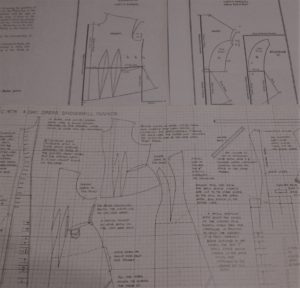The science and geometry of dress
by Jackson, Louisa L., Mrs. [from old catalog]
Published 1876
So, the trouble with the system is the “bust” measure is a sort of not really measurable distance where the armhole (arm size) and the side seam end. And then you take the back measure separately. Not a full measure all the way around. I used my padded form but still estimated where the side seams would sit. I think I need to tweak it a bit more. But other than my near universal shoulder/side of bust fitting issues I think the scale works.
If I look at the patterns taken from existing garments the arm hole is most definitely not as per the first pass of the tool. I need to get a bit courageous about trimming here! Also to adjust the super rigorous dart placement- the drafting tool is quite old fashioned in that it feels like it’s from the 1860s-very early 1870s. This is about the time there should be two side back seams that slope a little more gently. So I think the tool will work, it just won’t look like the diagrams but will look like the extant items.
The additional steps to make a basque though are brilliant. And it does show exactly why the cross dart sits where it does. This is where fabric naturally folds in at the waist with the basque (called skirts in this book.)
You can see how the fabric is super full in the armscye and above the bust. I’ll smooth the fabric over the stand and then compare to the tool to see what I would recommend in terms of using modern equipment.
The book is very unyielding in the sens that the distance from CF and CB to first dart is specified. And the distance between darts also specified. The tops of the darts are also very much decided by the tool (while the height is adjustable the distance from centre front is not.
I do love the basque and how the darts are formed! If nothing else I am keeping the dart tool!
I compared the diagrams to extant patterns and yes, I will need to do what these do: rotate the armscye towards the centre front.
These are all from Patterns of Fashion.






